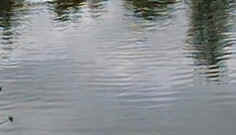
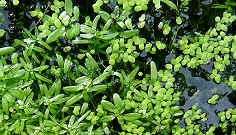



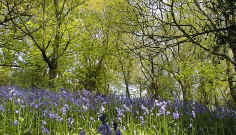
Open Freshwater
Submerged Plants
Swamp
Marsh
Climax Woodland
There will be micro-organisms and plankton floating in the water.
Images here.
The water depth will gradually decrease, allowing rooted, submerged plants, such as starwort and pondweed to grow. Waterlilies, which are rooted, but with floating leaves may also become established.
Fringed Water-lily
Nymphoides peltata
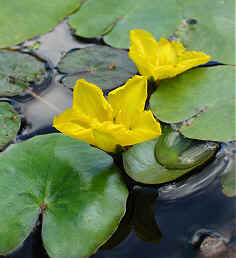
Floating plants, such as duckweed, may also be present.
With the added plant life will also have come a great variety of invertebrates and fish. The large numbers of different species present give rise to complex foodwebs.
The vegetation traps and holds more and more of the incoming sediment, so that the water becomes shallower.
Decomposing dead plant and animal matter provides food for detritivores and increases the nutrients in the water. This promotes plant growth.
Yellow Iris
(Yellow Flag)
Iris pseudacorus
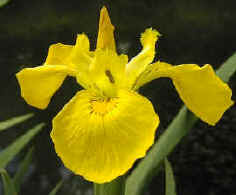
Branched Bur-reed
Sparganium erectum
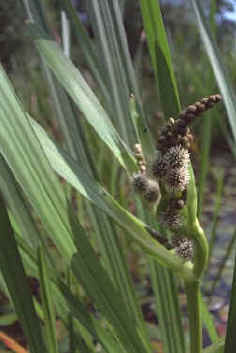
Greater
Reedmace
Typha latifolia

These plants tend to have tall, flexible spear-shaped leaves. This allows the plants to cope with large fluctuations in water level, always retaining some portion of the leaves above the water for effective photosynthesis.
The water in swamp areas teems with invertebrate life. It also provides an ideal place for frogs to spawn.
Frog Spawn

The leaf bases of the swamp plants are extremely effective at retaining incoming silt, particularly in the winter when the leaves have died back (below). Rotting plant material progressively builds up, which also raises the ground level.

Some plants such as Yellow Iris, which grow equally well in swamp or marsh conditions, will continue to grow, while marsh plants such as Water Mint, scent the air with minty aromas when crushed.
Water Mint
Mentha aquatica

These damp areas provide a wonderful transition habitat for young amphibians such as frogs and toads newly emerged from the water. At this point they are very small and extremely vulnerable to drying out. The lush wet vegetation provides an ideal hiding place.
Common Frog
Rana temporaria

However, their presence will also attract predators such as Grass Snakes. A Marsh is a good place to spy Grass Snakes (which are not poisonous!) basking in the sun.
Tree seedlings, such as willow, which favour wet soil conditions, will become well-established and begin to grow up.
Willow has a very high transpiration rate, transferring large quantities of water from the sediment into the atmosphere. Together with the silt-trapping effect of the marsh plants, this greatly increases the rate at which the marsh dries out.
By now, the willow has grown up and dominates the ground. Willows will support a diverse range of invertebrates (more than 450 different species). This means that there is plenty of food for insectivorous birds such as Marsh Tits.
(For a list and information on birds surveyed in a wet woodland area, click here)
Alder, another tree which flourishes in wet conditions may also be present. Many of the marsh plants will have been shaded out by the trees.
They are replaced by a variety of woodland floor plants including sedges, rushes, ferns and small flowering herbs which are adapted to low light levels and which flourish in wet conditions.
Star Sedge
Carex echinata
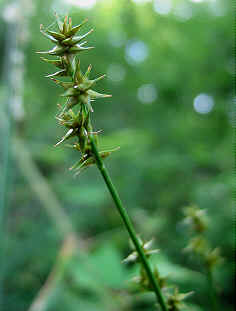
Golden Saxifrage
Chrysosplenium
oppositifolium
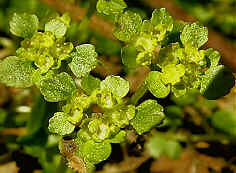
A variety of fungi which grow well in wet soils will also become established. In the more boggy patches of the woodland, the bright orange fruiting bodies of the fungus, Mitrula palludosa might be spotted protruding from the soil like miniature lollipops.
Fruiting Bodies of
Mitrula palludosa
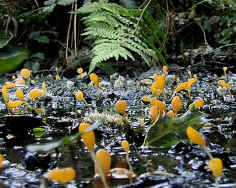
In drier areas, increasingly aerobic decomposition will accelerate nutrient recycling, elevating the humus and nutrient content of the soil.
Tree transpiration will continue to dry out the soil to the point where climax tree species such as Oak, Beech or Ash can become established.
The particular climax tree species which eventually dominates the woodland will depend on soil type and other environmental conditions. In many parts of Britain, the climax community is likely to be a mixed Oak wood.
The number of species making up the woodland community is very dependent on the structure of the wood and on how much light gets through to the woodland floor.
Where the ground is not too heavily shaded, herbs such as Wood Anemone and Wild Garlic will flourish.
Wood
Anemone
Anemone nemorosa
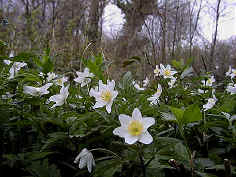
A ground cover of flowering plants and grasses will ensure that a variety of woodland butterflies are present.
Speckled Wood
Pararge aegeria
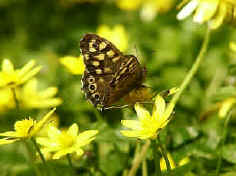
A different range of fungi will inhabit the climax woodland. Rotting wood provides microhabitats for many different fungi and invertebrates. The living trees are also hosts for a variety of mycorrhizal fungi, such as the Fly Agaric, which is associated with birch.
Fly Agaric
Amanita muscaria
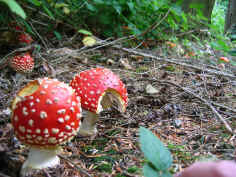
Many mammals will inhabit the woodland from Dormice (in southern counties of Britain) to squirrel, fox and badger.
Dormouse
Muscardinus avellanarius
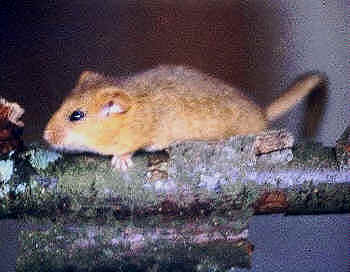
The number of different species present in a climax oak woodland community will run to many thousands.
Continue to Primary Succession
Find out about plant zonation in wetlands here.
Explore plant adaptations to life in and out of water here
Find out about woodlands and their management here.